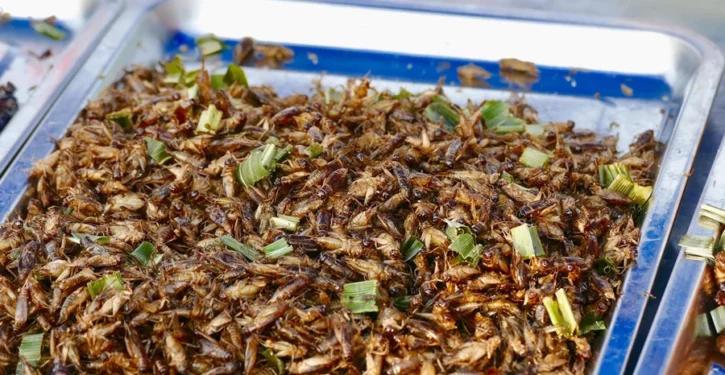are determined to radically restrict agricultural production of all types, and animal husbandry in particular. You are probably aware of the farmer protests going on in Europe. They are driven by the fact that European governments are shutting down agriculture in order to meet climate change goals.
They aren’t even just targeting farm animal production; they are actually limiting the use of fertilizer. They claim it is to reduce pollution. Ironically, the same governments reducing food production in the name of climate change are still going full speed ahead with using ethanol for fuel in the name of climate change. Reduce food production, but still convert food into fuel. Smart.
Substituting bugs for other forms of protein is supposed to be climate friendly, and hence desirable….The campaign to get people to eat bugs has been going on for a long time, but lately it has gone into overdrive. Bug promoters see inflation worries as a real opportunity to encourage people to switch from meat to insects, and they have seized the opportunity. Funny how that works–never let a crisis go to waste and all that.
The push for inserting insects into our diets comes from the highest levels of our government and culture. There is no demand for edible insects just dying to be filled. Animal husbandry is being squeezed, and globalist financiers are investing in bug production. Celebrities and marketing gurus are being recruited to push the product. And the result will be a scarcity of animal protein and a surplus of insects going cheap. Voila! Insects on the menu.
The European-based grocery chain Aldi is considering selling edible insects to help families through the cost-of-living crisis, reports the Daily Mail.
Scientists are developing meat alternatives such as maggot sausages, the New York Post reports:
Maggot sausages do not sound very tasty, compared to beef or pork sausages. But they are apparently tolerable, in terms of taste.
Some bugs taste better than others. Some are tasty even without seasoning, such as the periodical cicadas that come out of the ground in huge swarms once every 17 years in many eastern states. Even before the current progressive attack on farming, the Washington Post ran articles about people voluntarily eating periodical cicadas.
If you microwave cicadas for a short time, they become quite tasty and meaty. They can also be put in salads, pastas, and risottos, just the way chicken can. Even eaten raw, they are mildly tasty.
Periodical cicadas are an obvious food source because they make little effort to evade capture, do not fight back, and can easily be collected in plastic sandwich bags. They emerge from the ground in huge broods for a period of several weeks, after spending many years underground (10, 14, or 17 years, depending on the region).
After they emerge, they are devoured with abandon by dogs, rodents, and adventurous people in the U.S. Dogs that spend most of their time outdoors love eating cicadas so much they often end up getting constipated as a result of their feast on cicadas (eating lots of exoskeletons of raw cicadas can give you constipation).
Actress Nicole Kidman says “two billion people in the world eat bugs.” But not many Americans. By contrast, in southern Africa, people eat stinkbugs as a nutritious snack.
Most avid consumers of insects live in the Third World, not the West. Westerners often have a visceral distaste for the very idea of eating insects. For those that have this aversion, an alternative meat source might be guinea pigs, which are widely consumed in Peru. Guinea pigs are a much more efficient source of protein, per acre, than cattle, generating four times as much meat per acre. Guinea pigs also generate less net greenhouse gas emissions per pound of meat.
Eating insects rather than beef or pork reduces greenhouse gas emissions and pollution. As Benjamin Kolb notes at SciDevNet:
Insects caught in the wild are already eaten widely in the developing world. Now a study says that farming them on a large scale for food would damage the environment far less than equivalent livestock production.
Scientists compared emissions, by livestock and by insects, of the greenhouse gases methane and nitrous oxide, which have a greater warming effect than carbon dioxide. They also measured ammonia production, which harms the environment by acidifying soil and water.
They reared mealworms, locusts and crickets, all of which are consumed around the world, as well as sun beetles and cockroaches, which people do not eat, despite their potential as a protein source, while monitoring the amount of gas produced per kilogram of insect growth.
Compared to cattle, weight for weight, insects emitted 80 times less methane — a gas with 25 times more impact on global temperature levels than carbon dioxide.
And crickets produced 8-12 times less ammonia than pigs.
In places like the Netherlands, Europe’s biggest food exporter, elites have cracked down on the use of nitrogen fertilizers, even though the elimination of nitrogen fertilizers in Sri Lanka caused food production to collapse. Last year, Sri Lanka’s government banned fertilizer imports and told the nation’s farmers to practice organic agriculture instead. The result was a “man-made” food crisis as crop yields shrank and farmers stopped planting. The country went broke, and ran out of fuel. In its cities, deadly riots took place as people ran out of food and gasoline, and the President and Prime Minister were forced to resign.
Even as government elites make it harder for farmers to feed humans, they have imposed ethanol mandates and biofuel mandates that divert scarce cropland to raising corn for ethanol, and use farmland to produce biofuels instead of food. The result is to increase food prices across the world. Biofuel mandates drove up wheat prices in Egypt, triggering riots and contributing to the ouster of pro-American ruler Hosni Mubarak. Egypt is now run by a military dictatorship that is far more oppressive and wasteful than Mubarak’s rule. Related food price increases fueled terrorism and violence in places like Yemen and Afghanistan. They also contributed to hunger and child malnutrition in Guatemala.
The New York Times reported in 2013 that ethanol and biofuel mandates in the U.S. and Europe were fueling rising hunger in Guatemala, which had the fourth-highest rate of child malnutrition in the world — higher than in many less developed countries in Africa:
With its corn-based diet and proximity to the United States, Central America has long been vulnerable to economic riptides related to the United States’ corn policy. Now that the United States is using 40 percent of its crop to make biofuel, it is not surprising that tortilla prices have doubled in Guatemala, which imports nearly half of its corn.
In a country where most families must spend about two thirds of their income on food, ‘the average Guatemalan is now hungrier because of biofuel development.’. . .Roughly 50 percent of the nation’s children are chronically malnourished, the fourth-highest rate in the world, according to the United Nations.
The American renewable fuel standard mandates that an increasing volume of biofuel be blended into the nation’s vehicle fuel supply each year to reduce carbon dioxide emissions from fossil fuels and to bolster the nation’s energy security. Similarly, by 2020, transportation fuels in Europe will have to contain 10 percent biofuel.
Biofuel mandates had shrunk the amount of land used for producing food in countries like Guatemala:
Recent laws in the United States and Europe that mandate the increasing use of biofuel in cars have had far-flung ripple effects, economists say, as land once devoted to growing food for humans is now sometimes more profitably used for churning out vehicle fuel. In a globalized world, the expansion of the biofuels industry has contributed to spikes in food prices and a shortage of land for food-based agriculture in poor corners of Asia, Africa and Latin America because the raw material is grown wherever it is cheapest.




